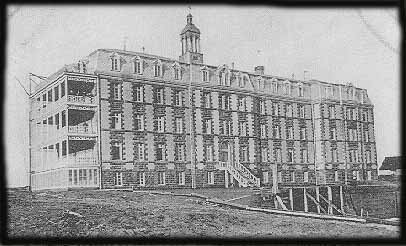 Marie Boudreau
Marie Boudreau
 Isaie Boudreau & Rose Boudreau
Isaie Boudreau & Rose Boudreau
 Athanase Boudreau & F�licit� Orillon,
Athanase Boudreau & F�licit� Orillon,
Pioneers of Beresford
 Ancestors of Marie Boudreau
Ancestors of Marie Boudreau
 Their Children
Their Children

Fabien was born in Petit-Rocher on November 4th and baptised November 17, 1828. He grew up in the same village where at the age of 23, he married Marie Bondreau on September 16, 1852. Together, they had at least 10 children and this family was also established in Petit-Rocher. Fabien Comeau died before the 1891 census and would not reach the age of 63.

Contrary to the social and economic development in the first half of the century, a few years after, this couple witnessed the rise of consciousness in the Acadian people which started in 1854 with the publication of the poem Evangeline . This was demonstrated by the creation of Acadian educational institutions, newspapers and the political involvement of certain Acadians.
This rise of consciousness did not occur without struggle. The Common Schools
Act of 1871 created a crisis among Acadians which was named the Caraquet Riots.
First Coll�ge du Sacr� Coeur
Built in Caraquet, N.B. in
the late 1800's
Rebuilt in West Bathurst, N.B. after fire in 1917

- Agnes Comeau born around 1851*; married Abraham Watson August 27, 1895
- Jacques Comeau born December 1, 1853; married Catherine Robinson October 5, 1891
- Marie Comeau born December 1857; married Jacques Richard May 15, 1898
- Jean Comeau born September 1862; died in 1952; married Marie Pitre November 25, 1890
- G�rard Comeau born May 17, 1866
- Victor Comeau born July 19, 1868
- Joseph Fabien Comeau born around 1867*; died February 1894
- Jer�me Comeau born February 1863
- Georgina Comeau born August 26, 1870
- George Comeau born around 1872*, died August 31, 1952; married Marguerite Arseneault May 19, 1896
* according to the 1891 census, living with their brother Jean Comeau.

HISTORICAL TIDBITS

In 1847, Henry Wadsworth Longfellow published the poem �vangeline * A Tale of Acadie *
which tells the story of the expulsion of the Acadian people from their homeland and awakened an interest in the history of Acadians.
Evangeline is based on the true tale of two lovers, Emmeline Labiche and Louis Arseneau, who were separated
when the British deported the Acadians from Nova Scotia in 1755.
For the first time, a story of the expulsion was written from the Acadian perspective and
attracted the world's attention to the tragedy.
The publication of the poem 'Evangeline' awakened a sense of awareness in the Acadian people
and spawned a change in their social and political influence.
Source: Acadia & Evangeline - Historical Perpectives

The Common Schools Act of 1871 created a crisis among Acadians known as the Caraquet Riots.
The act denied the Acadians their own French and Catholic schools and as
a result the Acadians refused to pay the education tax. Because of the unpaid taxes
the majority of the French people of Gloucester County, N.B. were ineligible to
serve on the district school boards.
On the 1871 census, there were only 71 English-speaking Protestants of the 3,111
residents in Caraquet. However all the economic and political
power in the region was held by two English men. Robert Young and James Blackhall
not only held all the power of the region, they also supported the school.
When James Blackhall held a meeting at the Caraquet school to fill the school
board with English-speaking people, the Acadians broke the meeting up. The
Acadians then threatened James Blackhall and forced him to sign a petition,
promising not to attend any more school meetings. In response to this event
Robert Young's clerk (a man named Colson Hubbard) circulated a note which
threatened to burn the Catholic priest's home.
The next day, about 100 Acadian men gathered outside Young's store and Young
was forced to barricade himself inside. Soon Sherriff Robert Vail arrived with a
force of English constables. Several Acadians were arrested and the crowd
dispersed.

On Jan. 26, 1871 violence erupted again as Young's gang entered the house of
Andr�e Albert with a warrant for Charles Parise. When they entered the house,
Constable Ramsay heard noises in the attic and opened fire. It is not clear
whether Charles Parise was even in the house but two men died as a result of the
shots fired in the attic; Louis Mailloux and John Gifford who was hit in the head and died
instantly. The next day 13 more Acadians were taken prisoner
and transported in sleighs to the Bathurst jail.
Acadian school in Petit-Rocher 1888

Last update: December 2, 2000
 Fabien Comeau
Fabien Comeau
 Evangeline
Evangeline
 The riots of Caraquet
The riots of Caraquet
 Marie Boudreau
Marie Boudreau
 Isaie Boudreau & Rose Boudreau
Isaie Boudreau & Rose Boudreau
 Athanase Boudreau & F�licit� Orillon,
Athanase Boudreau & F�licit� Orillon,
 Ancestors of Marie Boudreau
Ancestors of Marie Boudreau




